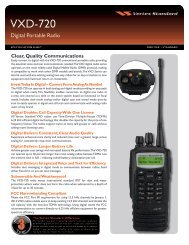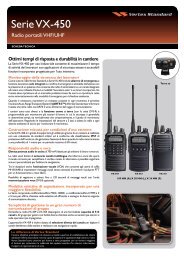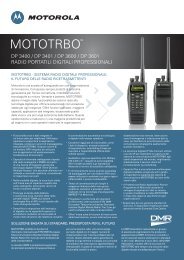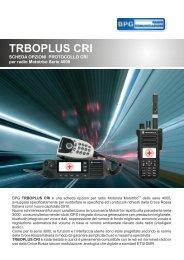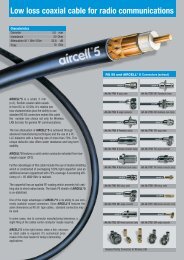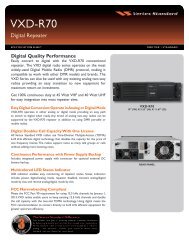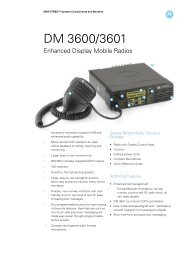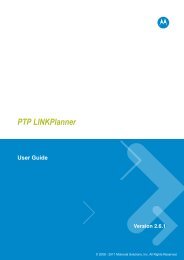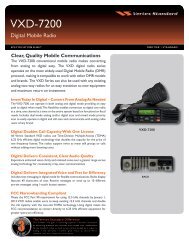Create successful ePaper yourself
Turn your PDF publications into a flip-book with our unique Google optimized e-Paper software.
IP-basedFAQCan we use our existing computer network to create an IP-baseddispatch system, or do we need to build a new one?The answer to this question depends on the IP dispatchsystem application. In many cases we can use existing IPnetworks, but in other cases, like public safety applications,you may want to think about creating a secure, standalonecommunications network. Here are a few things to considerwith regard to IP dispatch solutions:• How much traffic is on my existing network andhow much bandwidth is available to dedicate to acommunications solution?• Does your network support multicasting? Multicasting isan important element in making our dispatch solutions aseffective as possible. We can work with non-multicastingnetworks but there are some limitations.• Do you want to connect and communicate between multiplelocations or installations via an IP dispatch network? If so,that means you have to have a good network connectionbetween them. Anywhere you have a network connectioncould be a potential location for communications equipment.If you have offices across the country that are all connectedvia a network, you could communicate between them usingtwo-way radios because the network ties them together.How much bandwidth will the dispatch system use on the network?With a C-Soft low-bit vocoder, there can be a bandwidthsavings of up to 30 percent. This depends on how manyradios and dispatch positions you want on the system. Thebreakdown is simple: every device you connect to the systemthat operates in simplex mode requires 50 kBits of availablebandwidth. Multiply that times the number of radios you haveon the system—eight radios means 8 x 50 kBit or 400 kBitfor effective simultaneous communications. Always make surethe network has the capacity to account for the maximumpossible number of simultaneous transmissions.How important are SIP capabilities in a dispatch system?The Session Initiation Protocol (SIP) is a signaling protocolused for establishing sessions in an IP network. For aradio dispatcher, SIP is one way of bringing control oftelephone onto the console, be it a simple two-way call ora collaborative conference session. This allows dispatchto control phone calls incoming and outgoing phone callsand use features such as hold/unhold, call forwarding,conferencing, voice mail, and call transfer. One of the mostimportant features is the crosspatch capability of radioand phone. Now a police officer on a radio channel can beconnected to a phone call to coordinate activities or assistdispatch with a critical situation. SIP can be configured touse existing switches, so a large number of lines are availableif required. SIP is becoming an important part of dispatchconsoles. Like the IP console SIP is a powerful, yet simple toolwhich is also very flexible and scalable.I have two dispatch locations, but can only afford to update oneconsole to IP. Will I be able to communicate with the old console?In most cases, <strong>Telex</strong> will be able to interface an IP-223 orgateway to each channel at the location where the radioswould be interfaced to the analog console, usually the CentralElectronics Bank (CEB). The IP-223 is configured in consolemode, and allows the channels configured this way to be put onthe same IP network system as the new IP console. Through thenetwork, the analog console can be monitered and operatedlike it was another IP console. The flexibility of this designprovides a way for an end user to start a migration path to acomplete IP change over when replacing the dispatch cosoles inmultiple locations. When required, this concept also provides avery cost effective backup console to existing analog consoles.4 | www.telex.com/radiodispatch
C-SoftSoftware-based <strong>Radio</strong><strong>Dispatch</strong> ConsoleFeatures:Available configurations – available in configurations from 2 to 200 lines.User interface – user-controlled configurations for any dispatch application.Signaling capabilities – MDC-1200 encode and decode, MOTOTRBO,NexEdge, FleetSync encode and decode, DTMF, serial and OTA FleetSync,5/6 tone (supports emergency, group, individual and status calls).Instant recall recorder:• Tracks the last ten minutes of both select and unselect speaker audio.• Buttons can be set up to start playback at various points in the buffer, orplayed call-by-call from the call buffer.Information windows – per line call history, active emergency, emergencyhistory, manual call list, and status window.Intercom capabilities – intercom communications between dispatch positionscan be set up on all consoles on the system.DTMF keys – a full, 16-key keyboard is supported.Paging:• Multiple paging formats are built into the C-Soft console software.• Quickcall in both the 100 and 1000 group formats, as well as DTMF,Knox paging tone, and 5/6 tone paging.• Manual frequency entry mode is also supported.PC requirements:• Operating system: Windows XP andWIN7 “32 bit” formats• Network connection: 10 Mbps or100 Mbps TCP/IP connection• Processor speed: Intel Pentium dualCPU 1.8 GHz• Memory: minimum of 2 GB of RAMrecommended• Parallel applications: notrecommended to run otherapplications on PCs running C-Soft,especially those with high demands.NOTE: These are minimum requirements and usersshould bear in mind that when handling a largenumber of lines - 50 or more per PC – it is stronglyrecommended that more powerful computersand more robust network resources be deployed.Please consult your integrator for specific systemrecommendations.Alert tones:• Three alert-tone types are supported, including: steady tone, pulsedtone, and hi-lo warble.• All frequencies and durations are programmable.Programmed group & mute buttons – for both functions lines can beselectively included within these programmed buttons, allowing for instantaccess to particular lines of interest.Crosspatch – up to 30 simultaneous crosspatch groups are supported.Status indicators – 24-hour clock, VU meter, PTT indication, and InstantRecall Recorder progress are displayed on the upper status bar.Flexible audio interface options – using <strong>Telex</strong>’s new ADHB-4 and RHB,C-Soft can interface with all common dispatch communication audio sources,including headsets, desktop microphones, external speakers (up to six), andfootswitches.Multiple vocoders – per line vocoder type ability to select lower bandwidthvocoder.Special interfaces – MOTOTRBO , iDEN, TETRA, P25 and phone/PSTN.6 | www.telex.com/radiodispatch
C-Soft is the industry’s most flexible and capable softwaredispatch console — perfect application for any dispatchenvironment. C-Soft delivers all of the dispatch capabilitiesyou expect, while also giving you the flexibility that only anIP-based software console can provide: simple and quickdeployment in the field, easy back-up of communicationsassets, and the ability to save multiple configurationson a single computer. This proven application has beendeployed in communication centers around the world, inapplications from 911 dispatch to mobile command centersand transportation management.<strong>Telex</strong> C-Soft: A Proven Life-Saver for Okanogan County 911 CenterAs the third largest county in the continental United States,Okanogan County spans 5,281 square miles of ruggednorth-central Washington terrain that includes parts ofthe Cascade Range and the Columbia River Basin. With apopulation of about 40,000 dispersed over such a largearea, effective distance communication is critical at timesof emergency. “Our number-one focus is life-safety,” saysEmergency Manager Scott Miller of the Okanogan CountySheriff’s Office. “We cannot afford to have our radiosystems go down at any time.”Having built its emergency communications capabilitiesaround a <strong>Telex</strong> C-Soft platform several years ago, thecounty’s Emergency Management Department has hadplenty of opportunity to determine whether the systemmeets requisite standards for reliability and performance.The verdict? “It’s been solid as a rock for five years,” Millersays. “We’ve had absolutely no problems.”The dispatcher tells the responding unit what they know,and the unit gives the dispatcher status updates as theyrespond. All of this back-and-forth with the radios thattransmit over the air and talk to the Kenwood field radios isrouted through C-Soft and the IP-223s.”The C-Soft system supports flexible signal routing and thetailoring of user interfaces to custom needs. And with its<strong>Radio</strong> over IP (RoIP) architecture, all the traffic that wouldpreviously have required a multitude of analog audio linesbetween the dispatcher’s station and the radio transceiverscan now be handled over a single CAT-5 Ethernet cable.ROIP also gives the county far greater extensibility toremote locations. “We have a control station up on amountaintop,” Miller says, “and by putting in a networkswitch we were able to extend the network to that locationvia microwave, which is far more reliable than leasing a linefrom a phone provider.”Headquartered in Okanogan, the county seat, the Sheriff’sOffice operates the county’s 911 communications center,receiving all 911 calls and dispatching all first-respondersto in-county emergencies. The facility is equipped withthe IP-based C-Soft radio dispatch and signaling consoleas well as 25 IP-223 dual IP remote adapter panels, whichhandle conversion between digital and analog signals.The system also includes a number of DSP-223 toneremoteadapters, as well as two <strong>Telex</strong> Network Recorderswhich perform real-time call recording, supports remotemonitoring, and includes a searchable database for storageand retrieval of call information. “We really like the abilityfor supervisors to be able to call up recordings fromanywhere in the County IP network,” adds Miller.“We handle all of our public safety radio communicationsvia the C-Soft console,” Miller continues; “it’s how wecommunicate with all first responders in the county. The911 call comes in, the dispatcher takes the call, determinesthe nature of the problem, and then uses C-Soft to eithercommunicate directly with a specific first-responder unit,such as a nearby ambulance, or to send out a general page.At the time of the county’s initial purchase, RoIP was stillrelatively new in the radio dispatch field, which meant thatthere wasn’t a long track record to go by when selectinga manufacturer. “Looking back,” Miller says, “it’s now clearthat we made the right choice. We are very, very pleasedwith the C-Soft system. The system remains state-of-the artbecause <strong>Telex</strong> is continually developing the product withupdates and advancements that they have not charged usfor. Plus, <strong>Telex</strong>’s support has been outstanding, and we areconfident that they will still be here to support us five orten years down the road.”“The bottom line for us,” Miller continues, “is that we usethe C-Soft system in a critical life-safety setting, and we’vehad five years of running 24/7 without a hitch. That’s quitea testament to the system. We would highly recommend itto any other 911 center.”www.telex.com/radiodispatch | 7
BeaconSeriesADHB-4 & RHBAdvanced DigitalHeadset BoxRemote Headset BoxFeatures:Ethernet communicationSix audio channelsOne dual-channel 1/4” headset jackOne XLR connector to lowimpedancemicrophoneOne desk mic jackOne telephone handset jackOne NENA I/O jack with offhookdetectionSeparate headset volume knobsSupports three pairs of speakersUse with any standard amplifiedspeakerLED power and PTT indicator12 VDC operationTwo remote headset box connectionsVolume control knobLED for power/PTT indicationProgrammable gain controlFootswitch inputs for PTT andmonitorTwo relays with form-C contactsAUX inputs are DC isolatedColor LCD-type displayThe all-new Advanced Digital Headset Box (ADHB-4), anenhancement to the HB-3+, is our next generation radiodispatch headset adaptor. The ADHB-4 works exclusivelywith the <strong>Telex</strong> C-Soft console version 5.000 or later.It processes audio internally and communicates withC-Soft to transfer the signal via USB, which eliminatesdependence on the PC sound card. This allows users topurchase their own computer. While the current HB3+works with two speakers, the ADHB-4 supports up to sixspeakers per position.The ADHB-4 is the heart of the C-Soft console dispatchposition. It removes the barrier between users of differentPC audio platforms and enables them to relay vital, lifesavinginformation. To further enhance the flexibilityof the system, the ADHB-4 works with most desktopsystems running the latest Microsoft Windows 7. It is alsobackwards-compatible with Windows XP. In addition,the ADHB-4 includes all connections necessary forfull integration into the most common radio dispatchconfigurations.One of the most striking features of the ADHB-4 is itsfull-color LCD screen. This display hosts a rich interfacewhich provides the user with at-a-glance system statusupdates. With its Web capability, the ADHB-4 can also bemanaged via web interface. These advanced configurationoptions will bring peace of mind to dispatch operators,enabling them to focus on the critical task at hand. Ournew Remote Headset Box (RHB) allows up to two optionRHB’s to connect to the ADHB-4. This allows other usersto listen to the dispatch position (ie: supervisor, seconddispatcher).“<strong>Telex</strong> ROIP heads for the Stratosphere Casino in Las Vegas“Our PBX operators need to stay focused on the phonesand providing guest service rather than navigatingscreens or using complicated technology,” Lawney adds.“The interoperability between the phones, the GUI onthe computer screen and the IP-223 systems behind thescenes is as user-friendly as it is technologically seamless.The operators have the usual buttons that you would seeon a regular radio-base station on their screens and thechannels are arranged so that they can see them clearlywithout scrolling; they don’t need to do anything beyondclick on a screen button to view, scan, and send the callmessages out.”“Working with McIntosh and <strong>Telex</strong> was a greatexperience. There were no issues, no down time, and thesystem is a perfect fit for us.”— Melissa E. Lawney,Telecomm Specialist for American Casino & Entertainment Properties LLCwww.telex.com/radiodispatch | 9
IP-223Dual IP NetworkRemote AdapterPanelAvailable options:• FleetSync encode and decode• MDC-1200 encode and decode• iDEN interface with NI-223• TDI telephone interface required ifusing POTS• Multiple VocodersFeatures:<strong>Radio</strong> telephony operation – allowing local consoles to change to a remoteradio channel via POTS (Plain Old Telephone Service) line.Enhanced crosspatch capabilities:• Line-to-line crosspatch – enable and disable via DTMF strings.• Start/stop function tone line-to-line crosspatch – designated functiontones have the ability to automatically set up and knock down line-tolinecrosspatches within the device.• Dial – remote user with portable radio can key a DTMF string, causingIP-223 to take the TDI off-hook, dial a pre-programmed phone numberand establish a patch between the devices via DTMF strings.• Dial VoIP – remote user with portable radio can key DTMF string, causingan IP-223 to join different multicast group and port-mapping the IP to adifferent channel.• Phone patch – remote user with portable radio can key a DTMF string,causing IP-223 to take the TDI off-hook. The user can then manually diala phone number.• Multiple vocoders (per line vocoder type) – ability to select lowerbandwidth vocoder.Kenwood P25 TK5710/5810 serial control – supports encode and decode ofFleetSync ID and P25 ID, channel change, scan ON/OFF, and monitor. Alsocapable of direct serial control of Kenwood 80, 90, and 150 series radios.Generate FleetSync MSK signal at the IP-223 – DMR (Digital Mobile <strong>Radio</strong>)radio: NexEdge does not require specific Kenwood base station.Advanced compatiblity with multiple radio manufacturers – Motorola,Kenwood, EF Johnson, iDEN, and Sepura.Five-tone detection – decodes five-tone messages received from remoteradios and sends console information to the display.COR click dialing – while using COR (Carrier Operated Relay), the remoteuser can key click a portable radio, causing IP-223 to take TDI off-hook anddial a pre-programmed phone number to establish a telephone connectionbetween remote user and a designated dispatch console.Improved web-based programming interface – redesigned web pagedisplays important information on start screen and simplifies navigation tocritical programming areas.Encode iDEN emergency – able to receive and decode ID and informationrelated to incoming iDEN emergency signals.Sepura status messaging – able to decode and display status messagesgenerated via TETRA (Sepura SRM200/3500) radios.<strong>Telex</strong> System Manager (TSM) – easily detects <strong>Telex</strong> device on the networkfor easy firmware upgrade and configuration.10 | www.telex.com/radiodispatch
The <strong>Telex</strong> IP-223 IP Network Remote Adapter is the centerof our IP solutions. The IP-223 bridges two-way radios andother communications devices onto the IP dispatch network.Each IP-223 allows you to connect and control up to twocommunications devices from any dispatch location on thenetwork; that network can be within a single building, orcan reach across the entire country—wired or wireless. TheIP-223 also uses multiple types of communications interface:IP, two-wire, four-wire, iDEN, local control, and TDI withphone.IP-223 also offers seven functional modes:• Local – direct connection to any radio, bridging itonto the IP network.• Tone – generate standard control tones viaconventional connections to radio.• Console – bridge analog consoles into an IP dispatchnetwork.• Crosspatch/repeater – directly patch communicationsdevices on the network without a console. It can alsobe used to extend coverage.• Phone – connects a standard POTS telephone line tothe dispatch network via the TDI.• iDEN – puts iDEN phones onto the dispatch networkand provides advanced access and control.• TETRA – provides access to advanced features of theTETRA system via an interface with Sepura radios.“<strong>Telex</strong> ROIP for San Ramon Valley’s mobile ECCLocated in the San Francisco bay area, this one of manybusy emergency service departments relying upon thesolid performance of <strong>Telex</strong> IP-223 IP-based networkremote adapters for their mobile command vehicles.Suter states: “The system is easy to program and set up;we like how it provides channel-to-channel interoperabilitywith each console. Because we’re using mobile radios, we““I have been working with two-way radios for DPS goingon 25 years now, and RoIP is the neatest technology Ihave seen in communications yet. The ability to multicastover Ethernet is a powerful tool. RoIP has created endlessdon’t have the consoles set up to change channels—we’reusing all the capabilities of the radios. We can travel allover the bay area providing communications, and arenot restricted to 2, 16, 24 channels—the radios select thechannels. The IP-223 units are at the heart of an absolutelyuser-friendly dispatch system.”— Chris SuterSan Ramon Valley Fire District Communications CoordinatorDenver Public Schools use <strong>Telex</strong> for stability and effectivenesspossibilities for our two-way applications. We can designand add on to the <strong>Telex</strong> IP-223/C-6200 system in manydifferent ways. It’s a great platform to grow with.””— Jim Bailey,”Denver Public Schools <strong>Radio</strong> Roomwww.telex.com/radiodispatch | 11
MTRBi<strong>Radio</strong> Interfacefor C-SoftFeatures:<strong>Radio</strong> check/status – allows dispatchers to check the status of portables inthe field.<strong>Radio</strong> enable/disable (stun/revive) – allows dispatchers to enable and disableradios out in the field.Remote monitor – dispatchers can monitor the audio of a radio in the field.Zone & channel change – allows dispatchers to change zones and channelsconfigured in the MOTOTRBO professional digital two-way radio system.Scan controlANI with alias table – provides dispatchers with a call history.Call alert – notifies dispatchers of calls.Emergency alert – alerts dispatchers and supervisors in an emergencysituation and can provide GPS coordinates of the location.Outgoing text messaging – allows for communication between dispatcherand radio.Supports GPS/GIS – location tracking services integrated into C-Soft solution.MOTOROLA and the Stylized M Logo are registered in the U.S. Patent and Trademark Office. All other productand service names are the property of their registered owners. © Motorola, Inc. 2009Our newest addition to the <strong>Telex</strong> product family is theMTRBi interface. This interface allows a C-Soft softwarebased console to control the Motorola MOTOTRBOradio. Adding the <strong>Telex</strong> IP dispatch console allows one tohave a complete MOTOTRBO solution.Main advantages of our MTRBi is its ease of use,scalability, and reliability. It has a high level ofperformance, productivity and value!Different types of organizations, including public safety,government, commercial, health care, utilities, andtransportation can now get the features of Motorola’sMOTOTRBO with full console capability. <strong>Telex</strong>’s MTRBisolution is a very cost-effective and efficient solution.We support the features listed on the side, and are veryexcited about the text messaging and location trackingservices (GPS location tracking).12 | www.telex.com/radiodispatch
AccessoriesTDITelephone<strong>Dispatch</strong>InterfaceThis innovative technology allows dispatchers place andreceive calls from their console. A single analog phone linecan now be a shared resource among several IP-baseddispatch consoles in a facility.NI223 +iDENInterface tothe IP-223Users are able to change groups, initiate/terminate calls,crosspatch iDEN calls to other radio channels on thenetwork, communicate directly with the phone user, powerthe iDEN phone and pass caller ID information back to theconsole.IP-25300EFJ 25300Interface tothe IP-223Users have the flexibility to crosspatch the radio with anyother communication platform, including iDEN and a rangeof other two-way radios. The EFJohnson 5300 mobile radiois available in bands from VHF to 700/800 MHz and is usedaround the world.NEO-10Network Input/OutputControl DeviceThe NEO-10 is a network-based input/output device thathas 10 DPDT relays and 10 inputs for monitoring externalevents. Anytime a relay or input changes, the NEO-10 sendsa message across the network, allowing all console userson the system to see status updates in real time. Actualcontrol of the NEO-10 is accomplished by a TCP/IP socketconnection from the controlling console.HB-3 +Headset Adapter PanelMicrophone and headset input circuits allow end-usersto choose between electret and dynamic elementmicrophones. The HB-3+ contains its own microprocessorand software, giving it the intelligence and ability tocontrol multiple inputs and outputs. Sold with legacyhardware consoles.www.telex.com/radiodispatch | 13
Network RecorderFeatures:Faster CPU speed, more RAMDual 500 GB hardware RAID controlhard drivesEasy to recover the system in case offailureExportableSeparate OS drive250 GB SATA removable hard drivefor archiveAdditional archive hard driveavailableNetwork Recorder SoftwareThe new network recorder is sold in combinations of 12, 24, 50, and 100 licenses.The <strong>Telex</strong> Network Recorder allows you to monitor andrecord audio for any channel in real time. Stores detailedinformation for each call and event in an SQL databasefor quick and easy retrieval. This includes: Source IPaddresses, channel changes, crosspatch creation and teardown, Supervisor mode start and end, ANI, Date/time/callduration, Line number, Scan status and NEO-10 relay andinput logging.The recorder monitors the radio network for audio packetsand records specific criteria. These are stored as raw PCMaudio and then compressed into MP3 files. A 32-bit digitalsignature is added to the file to guarantee its authenticity.Both RX and TX audio are stored and separated for searchpurposes.Network Recorder monitor features:• Check for heartbeat, warning and errors• Established reporting messages –MP3 compression problemsDatabase connection/reconnect problemsProtect key (dongle) not foundSound card problemsHard drive fullDatabase rebuildingA line has been recording over 30 min.Accumulation of error filesLess than 20 GB left on hard drive recorderThe Remote Database Reviewer and Network Recorder’srelationship is as client and server. The Remote DatabaseReviewer (client) connects to Network Recorder (server),and a session is created. While the session is active, theRemote Database Reviewer is able to perform databasequeries and request audio from the Network Recorderserver. As long as the session is active, the session’s useraccount is also considered active. When the RemoteDatabase Reviewer is closed, the session ends, and theuser becomes inactive. The Network Recorder allows forsix sessions at a time.The <strong>Telex</strong> Remote Database Reviewer software is a stateof-the-arttool that enables users to remotely accessthe <strong>Telex</strong> Network Recorder’s database of audio filesfor playback and data export, to generate a report forportable viewing. The Remote Database Reviewer is ableto stream and copy audio files and data from the NetworkRecorder’s archive of recorded audio.Recorder Search Engine:The network search engine can search the recordercomputer using these parameters: ANI, line number, date,time, and call duration. Unrelated calls can be removedfrom the search screen, and calls of interest can be copiedfor playback on another computer or an MP3 player.Large groups of calls can be archived for permanentstorage and to clear disk space. Archived calls can thenbe brought back into the database for later review.14 | www.telex.com/radiodispatch
<strong>Telex</strong> System ManagerFREE!NO CHARGEfor thisapplication!Features:Option to save the configurationto a fileSelectively copy deviceparameters from one configurationto anotherImport or export to XML or CSVfile, ID directory, Crosspatch tableSave device configuration files tolocal disk for backup, archiving, orduplicationRecord configuration files back toa <strong>Telex</strong> deviceRequirements:• Windows XP SP2 or higher• NET Framework 2.0 or higher• Windows Installer 3.1<strong>Telex</strong> System Manager (TSM) software allows users toeasily configure <strong>Telex</strong> devices. TSM allows a user to viewand manipulate configuration parameters for the IP-223,IP-2002, and the IP-1616. In addition, TSM includesthe ability to update firmware on the IP-223, IP-2002,IP-1616, C-6200, and the NEO-10. <strong>Telex</strong> System Managerreplaces and improves upon the existing FTP <strong>Telex</strong> andConfiguration Saver programs.V.I.P.E.R.IP-based <strong>Radio</strong>Control SystemAll V.I.P.E.R. packages include:four <strong>Telex</strong> IP-223 radio controllers, external connection for up to eight differentportable radios, external Cat-5 network connection, internal network router,and a rugged weather resistant mil-spec case.V.I.P.E.R. MCU also includes:Nexus IP laptop computer12-line C-Soft dispatch console softwareand network recorder softwareBuilt-in storage drawers for laptopcomputer and accessories110-240 V @ 320 W max power supplyClosed dimensions:28” W x 29.5” D x 22.5” HV.I.P.E.R. eight also includes:110-240 V @ 100 W max power supplyClosed dimensions:28” W x 27.25” D x 15.5” HUse the V.I.P.E.R. to create completely self-containeddispatch networks that are easy to deploy in emergencysituations, providing effective communicationsinteroperability solutions. V.I.P.E.R. is based on a modulararchitecture, and it provides the flexibility to create an exactsolution for any application. Any authorized <strong>Telex</strong> <strong>Radio</strong><strong>Dispatch</strong> dealer or integrator can help design a system thatfits your needs. Our V.I.P.E.R. MCU and V.I.P.E.R. 8 can beconnected together to achieve expanded capabilities.Number of radios needed for controlEach Network Remote Adapter (IP-223) supports up to tworadios. The number of different radio systems you need tocontrol will determine the number of IP-223s to include.Number of pre-configured radios for installationWhen building a V.I.P.E.R., agencies and integrators oftenchoose to have their most commonly used radios built rightinto the unit.www.telex.com/radiodispatch | 15
HardwareConsolesIP-1616Eight-line IP-Based<strong>Radio</strong> <strong>Dispatch</strong>ConsoleFeatures:Simplex/full-duplex operation(field programmable)Cross-mute (Ethernet-based)Parallel console updateInstant Recall Recorder (IRR)<strong>Telex</strong> System Manager (TSM)easily detects <strong>Telex</strong> device on thenetwork for easy firmware upgradeand configuration.16-channel controlCross-patching of two to eight linesCommunications with cross-patchgroups while operating on unusedchannelsLine select call with alarmControls:• Monitor, intercom, and PTT button• Up to four alert tones• Crosspatch• Group select, two pre-determinedgroups• Supervisory control• 16-digit DTMF keypad• Volume controls• Parallel TX LED detect• Channel selection• Instant PTT• Four programmable buttons• Paging (two-tone, DTMF, manual)• A- and B-menu buttonsThe IP-1616 is a workhorse console that offers all thedispatch features and control that you would expect froma larger, more expensive solution. Multiple IP-1616s canbe used to control larger operations. Its smaller desktopfootprint takes up less room at the workstation, but stilloffers all the dispatch capabilities and controls you need.IP-1616 also offers:• Call history – up to last 50 incoming calls displayed.• Autodial – dials from history list and phone list.• Caller ID – displays phone, iDEN, MDC, FleetSync,TETRA and 5-tone.• NEO-10 support – two NEO-10 relays from the console.• iDEN support – full support of NI-223 features,including ID, Go-ahead beeps, signals and manual dial.• Scan features – scans for supported radios.• Emergency – decodes incoming emergency signalsfrom supported ANI formats.• Clear/coded transmit – transmits to EFJ RS5300mobile radio.The IP-1616 requires no CEB or additional CPU equipmentfor operation. All processing and control capabilities arecompletely self-contained within the unit. Requires agooseneck desktop microphone or dispatch headset foroperation—all sold separately.• <strong>Radio</strong> telephony operation – allows local console tochange channel of the remote radio via POTS line.Also gives operators the ability to designate certainlines to automatically fail-over to a standard POTSline if the IP connection fails.• Phone line interface – allows interfacing to a phone line.• Kenwood P25 TK5710/5810 serial control – supportsencode and decode of FleetSync ID and P25 ID,channel change, scan on/off, and monitor. Alsocapable of direct serial control of Kenwood 80, 90,and 150 series radios.• Generate FleetSync MSK signal at the IP-223 – doesnot require specific Kenwood base station.16 | www.telex.com/radiodispatch
C-620018-line IP/Analog<strong>Radio</strong> <strong>Dispatch</strong>ConsoleFeatures:Simplex/full-duplex operation(field programmable)Crossmute (hardwire)Parallel console updateInstant Recall Recorder (IRR)<strong>Telex</strong> System Manager (TSM)easily detects <strong>Telex</strong> device onthe network for easy firmwareupgrade and configuration.Programmable single or dualfunction tones16-frequency controlTwo- or four-wire (fieldprogrammable with optional linecards), local and E&MProgrammable squelch controlPaging (multiple formats)Supports NEO-10 controlsControls:• Monitor, intercom, and PTT button• Up to four alert tones• Crosspatch• Group select, three pre-determinedgroups• Supervisory control• 16-digit DTMF keypad• Volume controls• Parallel TX LED detect• Channel selection• Instant PTT• Four programmable buttons• Paging (two-tone, DTMF, manual)• Auxiliary, up to four buttonsThe C-6200 is a unique platform in the dispatchindustry that can function as either an IP-based or ananalog console, giving you the flexibility to deploy itin numerous settings. Perfect for any small to midsizedoperation, the C-6200 offers world-class dispatchcapability and can even be configured to bridge analogand IP assets within a single unit. It’s also the perfecthardware console back-up to the Nexus IP dispatchposition. The C-6200 requires no CEB or additional CPUequipment for operation. All the processing and controlcapabilities are completely self-contained within the unit.Requires a gooseneck microphone, desktop microphone,or dispatch headset for operation—all sold separately.IP-2002Two-line IP-Based<strong>Radio</strong> <strong>Dispatch</strong>ConsoleFeatures:Simplex/full-duplex operation(field programmable)Crossmute (hardwire)Parallel console updateInstant Recall Recorder (IRR)<strong>Telex</strong> System Manager (TSM)easily detects <strong>Telex</strong> device onthe network for easy firmwareupgrade and configuration.100 talkgroup/frequency controlCall history with autodialCaller ID (phone, iDEN, MDC,FleetSync, TETRA and 5-tone)Scan feature for supported radiosEmergency – decodes incomingemergency signals from supportedANI formatsControls:• Monitor, intercom, and PTT button• Up to two alert tones• Crosspatch• Supervisory control• 16-digit DTMF keypad• Volume controls• Parallel TX LED detect• Frequency selection• Menu button for direct menu access• Paging (two-tone, DTMF, manual)The perfect footprint for smaller operations or supervisorymonitoring situations, the IP-2002 is an IP-based dispatchconsole in a familiar desktop telephone form factor.<strong>Dispatch</strong>ers using the IP-2002 can initiate a cross-patchbetween the two lines, as well as inject audio into thecross-patch. A simple Ethernet connection places theIP-2002 on the network. The IP-2002 requires no CEB oradditional CPU equipment for operation—all the processingand control capabilities are completely self-containedwithin the unit. The console comes with a handset andpanel mic. Other microphone options are sold separately.www.telex.com/radiodispatch | 17
C-1616Six-line Analog ToneRemote ControlConsoleFeatures:Two- or four-wire per line(field programmable)Simplex/full-duplex per line(field programmable)Programmable squelch control perlineTX monitorSupervisory control16-channel controlTwo alert tone cadencing(keypad programmable)Crossmute per line (hardwire)TX notch filterWildcard groupings(function tones)Controls:• Select/Unselect status for each line• Selective call indication• 16-function tone button selection• TX all button• RX all button• Mute button• Alert button• AUX relay button• Intercom• PTT button• 16-digit DTMF keypad• Supervisory button• TX detect LED for selected audio• Line activity monitor LED for eachlineThe C-1616 is designed for easy field programmability. Itsmodular design offers selection and control of up to six basestations and 16 frequencies. The C-1616 comes standardwith two channels. Additional channels may be added byinstalling another two-line module—sold separately. Itsunique vacuum florescent display provides channel alpha/numeric indication, and features a clock and audio-levelmeter. Multiple consoles can be easily programmed byusing the serial port located on the back of each console.Unlike other manufacturers’ equipment, the C-1616 requiresno additional programming. Optional: handset/headset,gooseneck mic, desk mic, and footswitch.“<strong>Telex</strong> brings flexibility to University of Phoenix Stadium“The 24-hour stadium security team covers a multitudeof responsibilities during its rotating shifts, includingvideo surveillance, fire alarms, door/gate monitoring andanswering after-hour incoming phone calls. An easy-to-usedispatch system was essential, especially in terms of trainingnew staff and ensuring seamless operator turnover at theprimary dispatch position.”Creative Communications recommended a <strong>Telex</strong> C-Soft12-line basic dispatch console, using IP-223 to interfaceremotely with CDM base radios.— Nick Spiro,Creative Communications”18 | www.telex.com/radiodispatch
C-2002Two-line <strong>Radio</strong>Control ConsoleFeatures:Selective call indicationParallel console updateAlert toneTime duration of the PTTAudio delayFunction tones (programmable)Two- or four-wire (fieldprogrammable), local and E&MSimplex/full-duplex(field programmable)Programmable squelch controlCrossmute (hardwire)TX monitorSupervisory controlTX and RX notch filterProgrammable TX delayControls:• Monitor, intercom, and PTT button• Alert tone• ALT button• Mute, release, and select (per line)• Supervisory control• 16-digit DTMF keypad• Volume controls• Parallel TX LED detect• Frequency selection• Three simultaneous microphonesCompact, but still loaded with features, the reliableC-2002 offers cross-mute and supervisory capabilityand programmable squelch control, which eliminates theunwanted noise generally associated with line monitoring.The C-2002 can control two base stations and select upto 99 frequencies. This DSP-designed console can beprogrammed by using the DTMF keypad on the front ofthe console. Used with our mating DSP-223 series adapterpanels, the C-2002 meets all the needs and requirementsfor controlling remote base stations. The console comeswith a handset and panel mic. Optional: headset, desk mic,footswitch, and wall-mount kit.C-2000 & C-2000HSSingle-line <strong>Radio</strong>Control ConsoleFeatures:Programmable single ordual-function tonesTwo- or four-wire(field programmable)Simplex/full-duplex(field programmable)Programmable squelch controlTX monitorSupervisory controlCross-mute (hardwire)TX notch filterAlert tone/warble15 programmable DTMF addressesParallel console updateControls:• Monitor button• Intercom• PTT button• 16-digit DTMF keypad• Volume controls• Parallel TX LED detect• Frequency selectionThe C-2000 allows dispatchers to select and control a singlebase station and up to 100 frequencies. It’s also designed foreasy field programmability using the DTMF keypad. Usedwith <strong>Telex</strong>’s DSP-223 series adapter panels, this consolemeets all dispatchers’ needs and requirements for controllingremote base stations. Multiple consoles can be programmedby using the serial port located on the back of each console.Unlike other manufacturers’ equipment, the C-2000 requiresno additional software. The C-2000 console comes with abuilt-in mic. Optional: headset and desk mic. The C-2000HSincludes handset. Optional: desk mic and footswitch.www.telex.com/radiodispatch | 19
DSP-223Tone RemoteAdapter PanelTRA-223Tone RemoteAdapter PanelThe <strong>Telex</strong> DSP-223 provides a reliable means of remotelycontrolling two-way-radio base stations. The adapter canbe used in conjunction with all radio dispatch consoles, orother manufacturers’ (such as Motorola and GE) remoteconsoles that use the industry-standard sequential tonekeyingformat. The DSP-223 is interconnected to thedistant remote control console(s) by any voice-gradetransmission medium, such as a microwave link, leasedtelephone line, or a twisted-pair 600-ohm line. All DSP-223s are capable of decoding the PTT (push-to-talk/transmitter-on) tone sequence and the voice-plus-tonesignals during transmission. All models are prepared forjumper plug conversion from two-wire line operation tofour-wire line operation. In the four-wire mode, the panelsare full-duplex capable.The TRA-223 tone-adapter is a simple way to remotelycontrol radio base stations. The TRA-223 can be usedin conjuction with all <strong>Telex</strong> analog consoles, or othermanufacturers’ consoles that use the industry-standardsequential tone keying format.Base stations can be connected to the distant remotecontrol console(s) by any voice-grade transmissionmedium-microwave link, a leased telephone line, or atwisted pair 600 ohm line, and are capable of decodingthe PTT and monitor function tone sequence. The TRA-223 also features a front panel dip switch that allows youto select various options, such as two- or four-wire lineoperation, along with full-duplex.DH2000Single-side HeadsetDH2200Dual-side HeadsetFeatures:Weighs 3.2 ouncesMic-noise-canceling electretmicrophoneEar seals foamThree-year warrantyThe DH2000 & DH2200 headsetsleverage technology from the <strong>Telex</strong>Airman 750 headset, which is a bestin-classlightweight headset. A flexibleboom allows microphone adjustmentto preferred side, and the adjustablestainless steel headband makes itcomfortable—even on the longest ofshifts.DH3000Single-side Noise-Canceling HeadsetDH3200Dual-side Noise-Canceling Headset20 | www.telex.com/radiodispatchFeatures:Weighs 4 ouncesTotal noise reduction 12 dBsVolume controlMic-noise-canceling electretmicrophoneEar seals plush foamThree-year warrantyDH-3000 & DH3200 are our noisecancelingheadset options, which arevery light, with ear cups and cushionsenlarged from previous models toenhance comfort. Other featuresinclude a set-and-forget volumecontrol and fully flexible boom. Thisheadset dramatically improves theclarity of communication and does notrequire batteries or panel be poweractivenoise reduction powered bymicrophone bias.
MD-MS 0118022Omni-DirectionalElectret MicrophoneSpecifications:Type: DynamicDirectivity: Omni-directionalSensitivity: -14 ± 4 dB at 1 kHz (0 dB=1 Vmicrobar)Frequency Response: 200 Hz-5 kHzCable: 4 conductor, 2 shield, 1.5 m 3 5 cmDimensions: H 1.43 mm, W 67.5 mm, L 12.9 mm6513C 30190500Noise-CancelingDynamic MicrophoneDT-GN-18Desktop GooseneckMicrophoneSpecifications:Frequency Response: 125 Hz-5000 HzPolar Pattern: Cardioid, noisecancelingImpedance: 150 ohmsOutput Level: -57 dB (0 dB=1 mW/10dynes/cm 2 )Case Material: Pressure-cast zinc andCycolacSpecifications:Frequency Response: 100 Hz-15000 HzGeneration Element: Condenser,back-electretSensitivity, open circuit voltage: 8.0mV (-42 dB)/pascal @ 1 kHzPower Level, 1 kHz (0 dB=1 mW/pascal): -44 dBPolar Pattern: CardioidDynamic Range: 102 dBMounting: Male threaded TRSNet weight: 822 g (1 lb 13 oz)Switch: Leaf, DPDT, switches externalcircuit and shorts/opens mike in offpositionFinish: BlackCable: 2.13 m (7ft) long, 5-conductor,2-shielded, vinyl jacket, blackDimensions:246.1 mm H, 114.3 mm W, 122.2 mm L**windscreen furnishedColor: Non-reflecting blackPower Requirements: 1.5 VDC to 9VDC phantom supplyOutput Impedance: Compatible withRTS keypanelsCurrent Consumption: 135 dB SPLDynamic Range: >109 dB**windscreen furnishedOutput Impedance, 1 kHz: 200 ohmsEquivalent Noise:
SystemDiagramSince <strong>Telex</strong> IP dispatch utilizes an Ethernet data network as its backbonefor all the components, communications is possible to and fromanywhere a user has access to an IP network. VoIP networks are easilyexpanded to grow with users’ needs, and the number of end users thatcan be added to the network is virtually unlimited. Get in touch with<strong>Telex</strong> and let us help you control your communicaitons with IP.NetworkRecorderIP-2002101010101010101010101010101010101010101010101010101010101010101011010101010101010101010101010101010101010101010101010101010101010101010101010101010101010101010101010101010101010101010101010101010101010101010101010101010101010101010101010101010101010101010101010101010101010101010101010101010101010101010101010101010101010101010101010101010101010101010101010101010101010101010101010101010101010101010101010101010101010101010101010101010101010101010101010101010101010101010101010101010101010IP-1616IP-22322 | www.telex.com/radiodispatchradio tower
NEO-10Door control, monitor power,temperatures, and otherconsole functionsNexus Positionwith ADHB-40101010101010101010101010101010101010101010101010101010101010100101010101010101010101010101010101010101010101010101010101010101101010101010101010101010101010101010101010010101010101010101010101010101010101010101101010101010101010101010101010101010101010010101010101010101010101010101010101010101101010101010101010101010101010101010101010101010101010101010101001010101010101010101010101010101010101010101010101010101010101011010101010101010101010101010101010101010101010101010101010101010IP-223/control radioBase Stationradio towerwww.telex.com/radiodispatch | 23
Bosch Security Systems, Inc.<strong>Telex</strong> <strong>Dispatch</strong> Products8601 East Cornhusker HighwayLincoln, NE 68507(800) 752-7560www.telex.com/radiodispatch© 2010 Bosch Security Systems, Inc. LIT000370003



